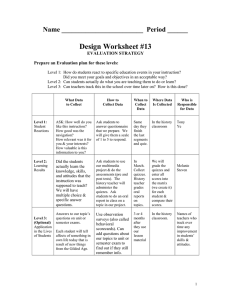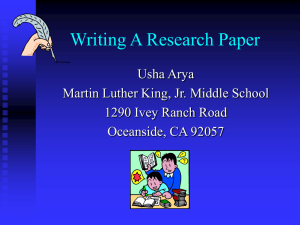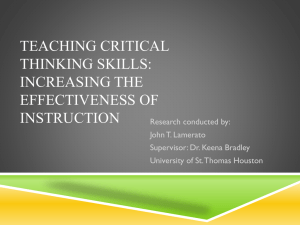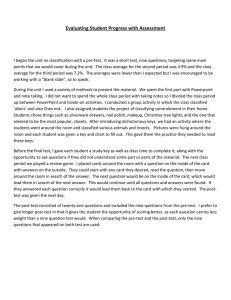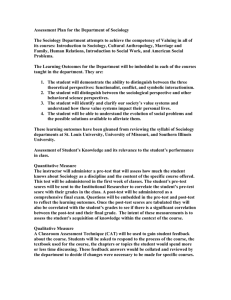2014-2015 Annual Program Assessment Report
advertisement
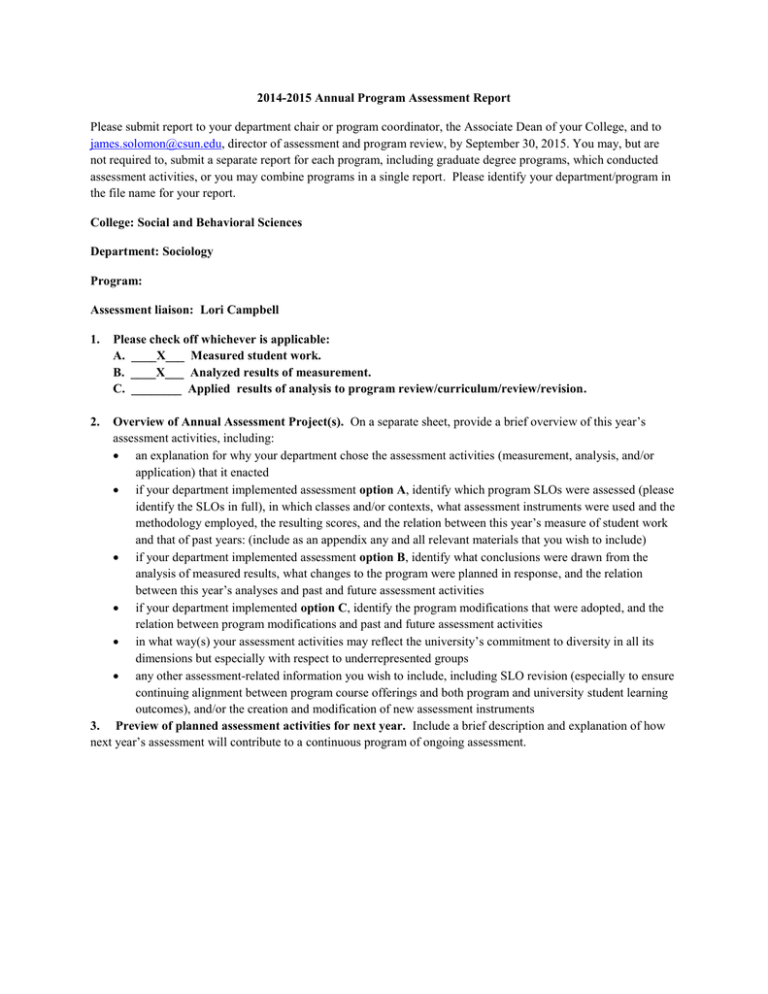
2014-2015 Annual Program Assessment Report Please submit report to your department chair or program coordinator, the Associate Dean of your College, and to james.solomon@csun.edu, director of assessment and program review, by September 30, 2015. You may, but are not required to, submit a separate report for each program, including graduate degree programs, which conducted assessment activities, or you may combine programs in a single report. Please identify your department/program in the file name for your report. College: Social and Behavioral Sciences Department: Sociology Program: Assessment liaison: Lori Campbell 1. Please check off whichever is applicable: A. ____X___ Measured student work. B. ____X___ Analyzed results of measurement. C. ________ Applied results of analysis to program review/curriculum/review/revision. Overview of Annual Assessment Project(s). On a separate sheet, provide a brief overview of this year’s assessment activities, including: an explanation for why your department chose the assessment activities (measurement, analysis, and/or application) that it enacted if your department implemented assessment option A, identify which program SLOs were assessed (please identify the SLOs in full), in which classes and/or contexts, what assessment instruments were used and the methodology employed, the resulting scores, and the relation between this year’s measure of student work and that of past years: (include as an appendix any and all relevant materials that you wish to include) if your department implemented assessment option B, identify what conclusions were drawn from the analysis of measured results, what changes to the program were planned in response, and the relation between this year’s analyses and past and future assessment activities if your department implemented option C, identify the program modifications that were adopted, and the relation between program modifications and past and future assessment activities in what way(s) your assessment activities may reflect the university’s commitment to diversity in all its dimensions but especially with respect to underrepresented groups any other assessment-related information you wish to include, including SLO revision (especially to ensure continuing alignment between program course offerings and both program and university student learning outcomes), and/or the creation and modification of new assessment instruments 3. Preview of planned assessment activities for next year. Include a brief description and explanation of how next year’s assessment will contribute to a continuous program of ongoing assessment. 2. 2. Overview of Annual Assessment Project(s). In 2013 - 2014, we changed our assessment strategy and revised our instruments. Thus, our plan for 2014 – 2015 was to use these revised instruments to measure student learning and analyze the results. We assessed three SLOs in spring 2015. They include: (1) Students will be able to recall and comprehend concepts, principles, theories, and knowledge in the field of Sociology and as related to their particular option. (2) Students will be able to recall and interpret common statistics used in Sociology. (3) Students will demonstrate the ability to collect, process, and interpret research data. We focused our assessment on our four core courses: Soc 368: Sociological Theory I, Soc 468: Sociological Theory II, Soc 364: Social Statistics, and Soc 497: Research Methods. Last year (in 2013 – 2014) we developed four separate instruments that served as objective measures of student learning in these courses. This year, we measured student learning by comparing what students knew at the beginning of each course in a pre-test and at the end of the semester with a post-test. Below I describe the methodology and results in greater detail. Assessment of SLO 1: Classical Theory (Soc 368) and Contemporary Theory (Soc 468) The first SLO was studied by surveying all students enrolled in all sections of two core theory courses, SOC 368: Sociological Theory I (aka Classical Theory) and SOC 468: Sociological Theory II (aka Contemporary Theory). Assessment of student learning was based on a 6-item multiple choice test for Classical Theory and a 6-item test for Contemporary Theory. Students completed the assessment tests online via Moodle. For the assessment of learning in classical theory, N=230 out of 257 students completed both the pre-test and post-test, for a response rate of 89.5%. The results show a pre-test average of 3.9/6 (65%) compared to an average 5.0/6 (83%) on the post-test. This is an increase of 18% from pre-test to post-test. The distribution of students’ scores is in Table 1. What is important to take away from Table 1. is that 66% of students taking the pre-test scored a D/F compared to only 27% on the post-test. This is strong evidence of student learning. Table 1. Results from Classical Theory Assessment For the assessment of learning in contemporary theory, N=130 out of 163 students completed both the pre-test and post-test, for a response rate of approximately 80%. The results show a pre-test average of 2.7/6 (45%) compared to an average 3.55/6 (59%) on the post-test. This is an increase of 14% from pre-test to post-test. The distribution of students’ scores is in Table 2. Our results show that approximately 71% of students taking the pre-test scored a D/F compared to 44% on the post-test. This is an improvement of 27%. Again, while I 2 believe that this is strong evidence of student learning, we do have a sizeable percentage of students with low scores on the contemporary theory assessment. Table 2. Results from Contemporary Theory Assessment Distribution of Grades on Pre-Test A (6/6) B (5/6) C (4/6) D (3/6) F (2 or lower) 3% 10% 16% 23% 48% Distribution of Grades on Post-Test A (6/6) B (5/6) C (4/6) D (3/6) F (2 or lower) 13% 17% 27% 15% 29% Assessment of SLO 2: Social Statistics (Soc 364) The second SLO was studied by surveying all students enrolled in all sections of SOC 364: Social Statistics. We assessed students’ understanding of statistics with a 7-item multiple choice test. N=268 out of 306 students completed both the pre-test and post-test, for a response rate of 87.6%. The results show a pre-test average of 3.5/7 (50%) compared to an average 4.5/7 (64%) on the post-test. This is an increase of 14% from pre-test to post-test. The distribution of students’ scores is in Table 3. It is clear from these data that our students struggle when learning statistics. On the pre-test, 23% of students scored a C or better while 77% scored a D/F. Looking at the post-test data, 51% scored a C or better and a sizeable 49% still earned a D/F. While I am pleased that the post-test data show a 27% increase in students scoring a C or better, we still have a long way to go in helping students better understand statistics. Table 3. Results from Statistics Assessment Distribution of Grades on Pre-Test A (7/7) B (6/7) C (5/7) D (4/7) F (3 or lower) 1.5% 7.1% 14.6% 28.4% 48.5% Distribution of Grades on Post-Test A (7/7) B (6/7) C (5/7) D (4/7) F (3 or lower) 7.10% 16.40% 27.20% 26.10% 23.10% Assessment of SLO 3: Research Methods (Soc 497) The third SLO was studied by surveying all students enrolled in all sections of SOC 497: Research Methods. We assessed students’ understanding of methods with a 9-item multiple choice test. N=205 out of 223 students completed both the pre-test and post-test, for a response rate of 92%. The results show a pre-test average of 4.5/9 (50%) compared to an average 5.6/9 (62%) on the post-test. This is an increase of 12% from pre-test to post-test. The distribution of students’ scores is in Table 4. On the pre-test, just 12% of students scored a C or better while 87% scored a D/F. Looking at the post-test data, 34% scored a C or better, while 3 45% still earned a D/F. The post-test data show a 22% increase in students scoring a C or better, however, the percentage of students who earn D/F remains large. Table 4. Results from Research Methods Assessment Distribution of Grades on Pre-Test A (9/9) B (8/9) C (7/9) D (6/9) F (5 or lower) 1% 3% 8% 16% 71% Distribution of Grades on Post-Test A (9/9) B (8/9) C (7/9) D (6/9) F (5 or lower) 4% 11% 19% 21% 45% Conclusions & Future Plans We revised our assessment instruments and revamped our assessment methodology. Broadly, the results of our assessment of the department’s four core courses show an increase in student learning from pre-test to post-test. However, we continue to find that a substantial percentage of students have low scores on our assessments. This is evidence that some of our students are struggling with theory, methods and statistics. Some of the low scores may also be the result of students not taking the assessment tests seriously. As an example, on the post-test assessment for contemporary theory, 30/130 students answered the 6 questions in less than two minutes, spending 20 seconds per question on average. Because our tests take place outside class (online in Moodle) and are not counted as part of the student’s grades, it is challenging to get students to perform at their best and take the assessment seriously. We have not made program changes at this time as we are still analyzing results and trying to determine how to improve student learning in these core courses. I do not compare this year’s results with those of the past because both our assessment methodology and instrument changed such that comparisons do not make sense. 3. Preview of planned assessment activities for next year. In the future we plan to use data from CSUN’s Institutional Research to investigate whether there are differences in student learning (i.e., an achievement gap) across different social groups. Perhaps if we can identify students most likely to struggle in our core courses, we can develop a remediation program, some type of intervention, or an effective tutoring program to help them. We plan to continue assessing all students in all sections of Soc 368, 468, 364 and 497 every semester. This will allow us to collect longitudinal data of student learning. We may revise the instruments again to increase the number of questions on each instrument. Lastly, we are in the process of revising our SLOs somewhat so that they reflect the key skills that we hope our students have when they graduate. 4

